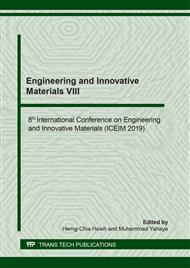[1]
S. B. G. Ć and D. U. Skala, DESIGN AND OPTIMISATION OF PURIFI- CATION PROCEDURE FOR BIODIESEL WASHING *,, vol. 15, no. 3, p.159–168, (2009).
Google Scholar
[2]
R. D. Shell, Separations Landscape for the Production of Biofuels Separations Landscape for the Production of BioFuels,, (2012).
Google Scholar
[3]
A. B. Koc and E. H. McKenzie, Effects of ultrasonication on glycerin separation during transesterification of soybean oil,, Fuel Process. Technol., vol. 91, no. 7, p.743–748, (2010).
DOI: 10.1016/j.fuproc.2010.01.020
Google Scholar
[4]
N. Sirirat, Bio-diesel production from transesterification using electric field. Master of Engineering Thesis. Department of Energy Engineering Graduate School, Chiang Mai University, Thailand., (2011).
Google Scholar
[5]
S. Mhatre et al., Electrostatic phase separation: A review,, Chem. Eng. Res. Des., vol. 96, p.177–195, (2015).
Google Scholar
[6]
H. S. Lee, C. Zheng, and B. Yang, Journal of Applied Mechanical Separation of Water-in-Oil Emulsions by Electrostatic Field at the Elevated Temperature,, vol. 7, no. 4, (2018).
Google Scholar
[7]
A. Abbaszadeh, B. Ghobadian, and G. Najafi, Electrostatic Coagulation for Separation of Crude Glycerin from Biodiesel Electrostatic Coagulation for Separation of Crude Glycerin from Biodiesel,, no. March, (2014).
DOI: 10.5772/52171
Google Scholar
[8]
G. V. Barbosa-Cánovas, M. M. Góngora-Nieto, U. R. Pothakamury, and B. G. Swanson, Preface,, Preserv. Foods With Pulsed Electr. Fields, p.6–7, (1999).
DOI: 10.1016/b978-012078149-2/50000-3
Google Scholar
[9]
D. C. Campos, E. L. Dall'Oglio, P. T. De Sousa, L. G. Vasconcelos, and C. A. Kuhnen, Investigation of dielectric properties of the reaction mixture during the acid-catalyzed transesterification of Brazil nut oil for biodiesel production,, Fuel, vol. 117, no. PARTB, p.957–965, (2014).
DOI: 10.1016/j.fuel.2013.10.037
Google Scholar
[10]
Samruay Sangsa-ar, High Voltage Engineering. Electric field stress and insulation durability. Bangkok. Thailand.
Google Scholar
[11]
D. Miklavčič, Handbook of Electroporation,, Handb. Electroporation, vol. 1–4, no. April, p.1–2998, (2017).
Google Scholar
[12]
M. S. Moonesan and S. H. Jayaram, Effect of pulsewidth on medium temperature rise and microbial inactivation under pulsed electric field food treatment,, IEEE Trans. Ind. Appl., vol. 49, no. 4, p.1767–1772, (2013).
DOI: 10.1109/tia.2013.2256411
Google Scholar
[13]
C. H. Chen, Kai Wu, Rui Su, and Shengtao Li, Influence of oil paper composition on the space charge characteristics,, CSEE J. Power Energy Syst., vol. 1, no. 3, p.10–15, (2015).
DOI: 10.17775/cseejpes.2015.00029
Google Scholar



